Japanese cuisine has become increasingly popular around the world, with its unique flavors and presentation attracting many food enthusiasts. The cuisine has a rich history, dating back to ancient times, and has evolved over the years to create the diverse range of dishes that are enjoyed today. From traditional dishes like sushi and tempura to modern favorites like katsu curry and ramen, Japanese food has something to offer for everyone. In this article, we'll explore the history and evolution of Japanese cuisine, as well as some of the unique dishes that have been popularized over time.
Traditional Japanese Cuisine
Japanese cuisine is deeply rooted in traditional values and culture, with a focus on fresh ingredients and simple, natural flavors. Many of the traditional dishes in Japanese cuisine have been enjoyed for centuries and have been passed down from generation to generation. One of the key aspects of Japanese cuisine is the emphasis on umami, or the fifth taste. This is achieved through the use of ingredients such as dashi, miso, and soy sauce, which create a rich and savory flavor in many dishes.
Some of the most well-known traditional Japanese dishes include sushi, tempura, and soba noodles. Sushi, which originated in Southeast Asia, became popular in Japan during the Edo period (1603-1868) and has since become one of the most popular dishes in Japanese cuisine. Tempura, which consists of deep-fried seafood and vegetables, has been enjoyed in Japan since the 16th century. Soba noodles, which are made from buckwheat flour and often served cold, have been a staple in Japanese cuisine for centuries.
Modern Japanese Cuisine
Japanese cuisine has evolved over time, with the introduction of new ingredients and cooking methods from around the world. The influence of Western cuisine, for example, has led to the incorporation of meat and dairy products in Japanese dishes. This has given rise to modern Japanese dishes such as katsu curry, tonkatsu, and Japanese-style curry, which are all popular among both locals and tourists.
In addition to these modern favorites, fusion cuisine has also become increasingly popular in Japan. Japanese-Italian and Japanese-French cuisine, for example, blend the flavors and techniques of both cuisines to create unique and delicious dishes. These fusion dishes have become particularly popular in major cities like Tokyo and Osaka, where there is a high demand for new and exciting dining experiences.
Regional Japanese Cuisine
One of the unique features of Japanese cuisine is the variety of regional dishes that are popular across the country. Each region of Japan has its own distinct flavors and ingredients, which have been shaped by local climate and geography. Kansai cuisine, for example, is known for its use of dashi and soy sauce, while Kanto cuisine is characterized by its use of miso and strong flavors.
Some of the most well-known regional dishes in Japan include okonomiyaki from Osaka, which is a savory pancake filled with vegetables and meat, and takoyaki from Tokyo, which are small, fried balls filled with octopus. Ramen, which is a popular noodle soup dish, also varies by region. Tonkotsu ramen, for example, is popular in Kyushu, while miso ramen is a specialty of Hokkaido.
Japanese Cuisine Around the World
Japanese cuisine has become increasingly popular around the world, with Japanese restaurants and food products being enjoyed by people in many countries. In fact, Japanese cuisine is now considered one of the most popular types of cuisine worldwide. The globalization of Japanese cuisine has given rise to many new dishes and culinary trends, with some restaurants and chefs even creating their own unique fusion cuisine.
One example of this is the popularity of sushi rolls in the United States, which feature a variety of non-traditional ingredients and flavor combinations. These sushi rolls have become a staple in many American restaurants, and have helped to popularize Japanese cuisine among people who might not have otherwise been interested in it.
The impact of Japanese cuisine on the wider food industry has also been significant. The popularity of Japanese food has led to a rise in food tourism in Japan, with many visitors coming to the country specifically to experience the unique flavors and culinary traditions of Japanese cuisine. This has led to the development of many new restaurants and culinary experiences, which in turn has helped to support local economies and businesses.
In conclusion, Japanese cuisine is a rich and diverse culinary tradition that has evolved over the years to create some of the most unique and flavorful dishes in the world. From traditional dishes like sushi and tempura to modern favorites like katsu curry and ramen, Japanese food has something to offer for everyone. Whether you're a food enthusiast or just looking to try something new, Japanese cuisine is definitely worth exploring.










